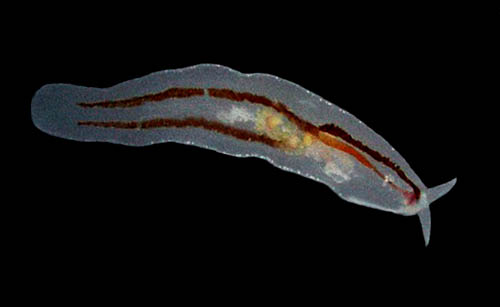_______________
Additional Photos

in field

|
Cephalopyge trematoides (Chun, 1889)

Maximum size: about 25 mm.
Identification:
The
body of this species is elongate and streamlined, tapering to a
blunt "tail." On the head are two smooth, contractile rhinophores and a
small rostrum is present. The foot, which is reduced to a small ventral
projection toward the anterior end, is capable of extending and
contracting. Through the transparent body can be seen the reproductive
and digestive glands that may vary in color. A few white flecks may be
present along the dorsal and ventral margins as well as on the
rhinophores.
Natural history:
Cephalopyge trematoides
is rarely seen due to its small size, transparent body and planktonic
habit. The single animal we've seen on Maui was found in open water
at 12 m (40
ft).
Adults may be free-living and swim by means of lateral undulations as
fast as seven undulations per
second. These waves, which run from the head to the tail, can propel
the animals forward at a rate of 12 cm/second. They may also attach to their prey
using a pedal gland. They feed on the siphonophores Nanomia bijuga, Halistemma sp. and Stephanomia sp. A cylindrical egg
strand is laid in the water column. (Lalli & Gilmer, 1989)
Distribution:
Big Island, Maui and Kauai: circumtropical.
Taxonomic notes:
The
genus name refers to the location of the anus (-pyge) on the dorsum
directly behind the head (cephalo-).
Photo: PF:
14 mm: found by Andy Schwanke; Alalakeiki Channel, Maui; Oct. 17, 1998.
Observations and comments:
Note
1: ( )
|
|


